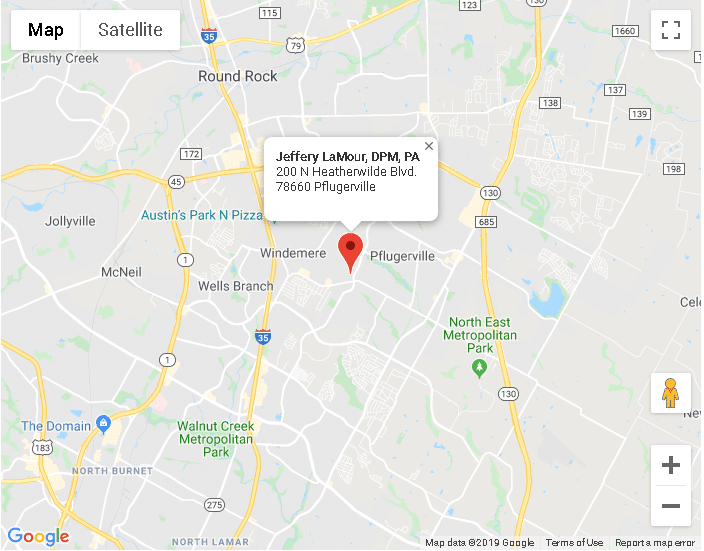If you’re suffering from athlete’s foot, you’re not alone. Athlete’s foot is a common condition. Estimates show 3% to 15% of the population has athlete’s foot. As a top-ranked podiatrist at his practice, Jeffery W. LaMour, DPM, PA, is skilled in the diagnosis of athlete’s foot and can help relieve your painful symptoms so you can go back to participating in your favorite activities. Dr. LaMour serves patients in Pflugerville and Austin, TX.
Athlete’s Foot Austin TX
What is Athlete’s Foot?
Athlete’s foot, or also known as tinea pedis, is a type of fungal infection that generally starts between your toes. You’re more likely to get it if you have feet that become extremely sweaty when wearing tightfitting shoes. This condition is related closely to other types of fungal infections like jock itch and ringworm.
Who is at Risk for Athlete’s Foot?
Anybody can experience athlete’s foot, but you increase your risk with certain behaviors. Some factors that could raise your chances of getting athlete’s feet are:
- Wearing closed-toe, tight shoes.
- Visiting public areas barefoot, particularly showers, locker rooms and swimming pools.
- Having sweaty feet.
- Keeping your feet wet for prolonged time periods.
- Sharing shoes, towels or socks with an infected individual.
- Having a minor nail or skin injury on your foot.
What are the Symptoms of Athlete’s Foot?
You can have athlete’s foot on one or both of your feet. There are also different types of athlete’s foot, however, with any type, you’re likely to see:
- Small, red blisters (typically between your toes or on your soles).
- Scaly, itchy red rash between your toes.
- Sores or ulcers that smell bad, leak fluid and look red.
- Ongoing scaling and dryness up the sides of your foot and on your soles.
What are the Causes of Athlete’s Foot?
Athlete’s foot occurs when your feet has tinea fungus growth on them. Causes include:
- Touching fungus contaminated surfaces.
- Coming in direct contact with an infected individual.
- The fungus thrives in moist, warm environments.
- Wearing damp socks or shoes.
- Moist, warm areas where it grows rapidly.
- Spending time at a public swimming pool or gym.
- Contaminated surfaces like shoes, floors and towels.
How Is Athlete’s Foot Treated?
In most cases, symptoms of athlete’s foot are mild and you don’t need a doctor visit. Treatment usually consists of medication.
You can buy over-the-counter medicines at pharmacies that can effectively clear up athlete’s foot. If you have a severe case, your doctor might prescribe stronger antifungal medicine, which you normally swallow. These kill the fungus. Antifungal medicines come in:
- Powders
- Tablets
- Creams
- Sprays
- Liquids
You can buy most topical medicines OTC. Topical is simply when you apply it directly to your skin.
Your pharmacist might suggest one of these antifungal medicines:
- Ketoconazole
- Clotrimazole
- Terbinafine
- Econazole
- Sulconazole
- Miconazole
There are also a large array of antifungal medicines you can buy online.
Your doctor might prescribe one of the following oral medicines if topical medications aren’t working or if your symptoms are severe:
- Itraconazole
- Griseofulvin
- Terbinafine
Please note, antacids could interfere with oral antifungal absorption. Also, oral antifungals might also interfere with how some types of anticoagulant medications work.
Your doctor might recommend hydrocortisone if you’re experiencing a lot of swelling and your skin is sore. You can find low-dose hydrocortisone online or OTC, but you will likely require a prescription for higher doses.
How Can I Prevent Athlete’s Foot?
To reduce your risk of developing athlete’s foot, you should always ensure you have dry and clean feet, socks and shoes.
Some ways to prevent athlete’s foot are:
- Keep your feet dry. Try using an antifungal talcum powder on your feet. At home, walk barefoot as much as possible.
- Wash your feet with soap and water twice daily and be sure to clean between your toes.
- Wear well-ventilated, loose-fitting shoes, particularly during the warm months. Canvas and leather make the best materials for shoes.
- Once sports or exercise has ended, remove your shoes.
- Ensure your feet are dry before you put on stockings, socks or tights. Wear socks made from silk, cotton, wool or other material that pulls moisture away.
- Wear pool slippers when walking around communal shower areas or changing room or public swimming pools.
- Don’t share footwear.
- Regularly change your shoes so your footwear is fairly dry. It takes time to dry out shoes.
Contact Dr. LaMour for Your Athlete’s Foot Condition
Dr. LaMour can determine the right treatment approach that will best eliminate your athlete’s foot condition. He’ll examine your foot and review your medical history and symptoms. He’ll then sit down with you and tailor a customized treatment plan to help you with your personal needs. Contact his office today to set up your appointment.

Austin TX
8015 Shoal Creek Blvd Suite 119Austin, TX 78757
Phone: (512) 451-3668
Pflugerville TX
200 N Heatherwilde BlvdPflugerville, TX 78660
Phone: (512) 451-3668



